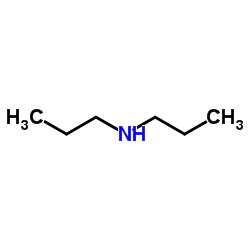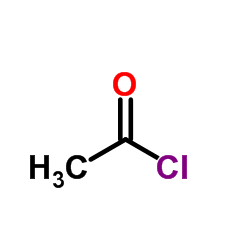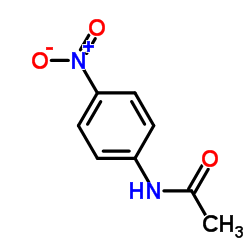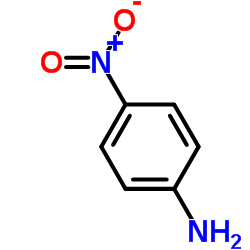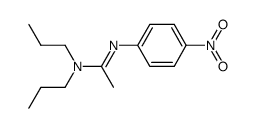1116-24-1
| 中文名 | N,N-二丙基乙酰胺 |
|---|---|
| 英文名 | n,n-dipropylacetamide |
| 中文别名 | 癫健安 |
| 英文别名 |
Acetamide,N,N-dipropyl
N,N-Dipropyl-acetamid EINECS 214-234-8 Acetyl-dipropylamin N,N-di-n-propylacetamide Essigsaeure-dipropylamid di-n-propyl acetamide N,N-dipropyl-acetamide |
| 密度 | 0.868g/cm3 |
|---|---|
| 沸点 | 207.3ºC at 760mmHg |
| 分子式 | C8H17NO |
| 分子量 | 143.22700 |
| 闪点 | 78.2ºC |
| 精确质量 | 143.13100 |
| PSA | 20.31000 |
| LogP | 1.65490 |
| 蒸汽压 | 0.227mmHg at 25°C |
| 折射率 | 1.4425-1.4445 |
| 储存条件 | 密封储存,储存于室温、干燥的库房。远离腐蚀区。 |
| 稳定性 | 常温常压下稳定。 与强氧化剂反应。 |
| 分子结构 | 1、摩尔折射率:42.86 2、摩尔体积(cm3/mol):164.9 3、等张比容(90.2K):381.1 4、表面张力(dyne/cm):28.5 5、介电常数:无可用的 6、极化率(10-24cm3):16.99 7、单一同位素质量:143.131014 Da 8、标称质量:143 Da 9、平均质量:143.2267 Da |
| 计算化学 | 1.疏水参数计算参考值(XlogP):1.5 2.氢键供体数量:0 3.氢键受体数量:1 4.可旋转化学键数量:4 5.互变异构体数量:无 6.拓扑分子极性表面积20.3 7.重原子数量:10 8.表面电荷:0 9.复杂度:95.4 10.同位素原子数量:0 11.确定原子立构中心数量:0 12.不确定原子立构中心数量:0 13.确定化学键立构中心数量:0 14.不确定化学键立构中心数量:0 15.共价键单元数量:1 |
| 更多 | 1. 性状:无色透明液体 2. 密度(g/mL,25℃):0.89 3. 相对蒸汽密度(g/mL,空气=1):未确定 4. 熔点(ºC):未确定 5. 沸点(ºC,常压):未确定 6. 沸点(ºC,6mmHg):87 7. 折射率(n20/D):1.4425-1.4445 8. 闪点(ºC):88 9. 比旋光度(º):未确定 10. 自燃点或引燃温度(ºC):未确定 11. 蒸气压(kPa,55ºC):未确定 12. 饱和蒸气压(kPa,25ºC):未确定 13. 燃烧热(KJ/mol):未确定 14. 临界温度(ºC):未确定 15. 临界压力(KPa):未确定 16. 油水(辛醇/水)分配系数的对数值:未确定 17. 爆炸上限(%,V/V):未确定 18. 爆炸下限(%,V/V):未确定 19. 溶解性:未确定 |
Synonym:None Section 2 - COMPOSITION, INFORMATION ON INGREDIENTS
Risk Phrases: 34 Section 3 - HAZARDS IDENTIFICATION EMERGENCY OVERVIEW
Causes burns.Corrosive. Potential Health Effects Eye: Causes eye burns. May cause chemical conjunctivitis and corneal damage. Skin: Causes skin burns. May cause cyanosis of the extremities. May cause skin rash (in milder cases), and cold and clammy skin with cyanosis or pale color. Ingestion: May cause severe and permanent damage to the digestive tract. May cause gastrointestinal irritation with nausea, vomiting and diarrhea. Causes gastrointestinal tract burns. May cause perforation of the digestive tract. May cause systemic effects. Inhalation: Causes chemical burns to the respiratory tract. Aspiration may lead to pulmonary edema. May cause systemic effects. Inhalation at high concentrations may cause CNS depression and asphixiation. Chronic: Effects may be delayed. Section 4 - FIRST AID MEASURES Eyes: Get medical aid immediately. Do NOT allow victim to rub eyes or keep eyes closed. Extensive irrigation with water is required (at least 30 minutes). Skin: Get medical aid immediately. Immediately flush skin with plenty of water for at least 15 minutes while removing contaminated clothing and shoes. Wash clothing before reuse. Destroy contaminated shoes. Ingestion: Do not induce vomiting. If victim is conscious and alert, give 2-4 cupfuls of milk or water. Get medical aid immediately. Inhalation: Get medical aid immediately. Remove from exposure and move to fresh air immediately. If not breathing, give artificial respiration. If breathing is difficult, give oxygen. Do NOT use mouth-to-mouth resuscitation. If breathing has ceased apply artificial respiration using oxygen and a suitable mechanical device such as a bag and a mask. Notes to Physician: Section 5 - FIRE FIGHTING MEASURES General Information: As in any fire, wear a self-contained breathing apparatus in pressure-demand, MSHA/NIOSH (approved or equivalent), and full protective gear. During a fire, irritating and highly toxic gases may be generated by thermal decomposition or combustion. Use water spray to keep fire-exposed containers cool. Water may be ineffective. Material is lighter than water and a fire may be spread by the use of water. Combustible liquid. Vapors may be heavier than air. They can spread along the ground and collect in low or confined areas. Containers may explode when heated. Extinguishing Media: In case of fire, use water, dry chemical, chemical foam, or alcohol-resistant foam. Use water spray to cool fire-exposed containers. Water may be ineffective. Section 6 - ACCIDENTAL RELEASE MEASURES General Information: Use proper personal protective equipment as indicated in Section 8. Spills/Leaks: Absorb spill with inert material (e.g. vermiculite, sand or earth), then place in suitable container. Avoid runoff into storm sewers and ditches which lead to waterways. Clean up spills immediately, observing precautions in the Protective Equipment section. Remove all sources of ignition. Use a spark-proof tool. Provide ventilation. Section 7 - HANDLING and STORAGE Handling: Wash thoroughly after handling. Remove contaminated clothing and wash before reuse. Use only in a well-ventilated area. Avoid contact with eyes, skin, and clothing. Empty containers retain product residue, (liquid and/or vapor), and can be dangerous. Keep container tightly closed. Keep away from heat, sparks and flame. Avoid ingestion and inhalation. Discard contaminated shoes. Do not pressurize, cut, weld, braze, solder, drill, grind, or expose empty containers to heat, sparks or open flames. Storage: Keep away from heat, sparks, and flame. Keep away from sources of ignition. Store in a tightly closed container. Store in a cool, dry, well-ventilated area away from incompatible substances. Corrosives area. Section 8 - EXPOSURE CONTROLS, PERSONAL PROTECTION Engineering Controls: Facilities storing or utilizing this material should be equipped with an eyewash facility and a safety shower. Use adequate ventilation to keep airborne concentrations low. Exposure Limits CAS# 1116-24-1: Personal Protective Equipment Eyes: Wear appropriate protective eyeglasses or chemical safety goggles as described by OSHA's eye and face protection regulations in 29 CFR 1910.133 or European Standard EN166. Skin: Wear appropriate protective gloves to prevent skin exposure. Clothing: Wear appropriate protective clothing to prevent skin exposure. Respirators: Follow the OSHA respirator regulations found in 29 CFR 1910.134 or European Standard EN 149. Use a NIOSH/MSHA or European Standard EN 149 approved respirator if exposure limits are exceeded or if irritation or other symptoms are experienced. Section 9 - PHYSICAL AND CHEMICAL PROPERTIES Physical State: Liquid Color: colorless Odor: acetic odor pH: Not available. Vapor Pressure: Not available. Viscosity: Not available. Boiling Point: 87 deg C @ 6.00mm Hg Freezing/Melting Point: Not available. Autoignition Temperature: Not available. Flash Point: 88 deg C ( 190.40 deg F) Explosion Limits, lower: Not available. Explosion Limits, upper: Not available. Decomposition Temperature: Solubility in water: Specific Gravity/Density: .8900g/cm3 Molecular Formula: C8H17NO Molecular Weight: 143.23 Section 10 - STABILITY AND REACTIVITY Chemical Stability: Stable under normal temperatures and pressures. Conditions to Avoid: Incompatible materials, ignition sources, excess heat, strong oxidants. Incompatibilities with Other Materials: Strong oxidizing agents. Hazardous Decomposition Products: Carbon monoxide, oxides of nitrogen, irritating and toxic fumes and gases, carbon dioxide. Hazardous Polymerization: Has not been reported Section 11 - TOXICOLOGICAL INFORMATION RTECS#: CAS# 1116-24-1 unlisted. LD50/LC50: Not available. Carcinogenicity: Acetamide, N,N-Dipropyl- - Not listed by ACGIH, IARC, or NTP. Section 12 - ECOLOGICAL INFORMATION Section 13 - DISPOSAL CONSIDERATIONS Dispose of in a manner consistent with federal, state, and local regulations. Section 14 - TRANSPORT INFORMATION IATA Shipping Name: CORROSIVE LIQUID, N.O.S.* Hazard Class: 8 UN Number: 1760 Packing Group: III IMO Shipping Name: CORROSIVE LIQUID, N.O.S. Hazard Class: 8 UN Number: 1760 Packing Group: III RID/ADR Shipping Name: CORROSIVE LIQUID, N.O.S. Hazard Class: 8 UN Number: 1760 Packing group: III Section 15 - REGULATORY INFORMATION European/International Regulations European Labeling in Accordance with EC Directives Hazard Symbols: C Risk Phrases: R 34 Causes burns. Safety Phrases: S 26 In case of contact with eyes, rinse immediately with plenty of water and seek medical advice. S 28A After contact with skin, wash immediately with plenty of water. WGK (Water Danger/Protection) CAS# 1116-24-1: No information available. Canada CAS# 1116-24-1 is listed on Canada's NDSL List. CAS# 1116-24-1 is not listed on Canada's Ingredient Disclosure List. US FEDERAL TSCA CAS# 1116-24-1 is listed on the TSCA inventory. SECTION 16 - ADDITIONAL INFORMATION N/A |
|
~% 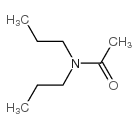
1116-24-1 |
| 文献:Roma, Giorgio; Piras, Daniela; Di Braccio, Mario; Grossi, Giancarlo Synthesis, 2010 , # 5 art. no. Z22309SS, p. 849 - 857 |
|
~0% 
1116-24-1
详细
|
| 文献:Hansen; Pedersen 1980 , vol. 34, # 5 B p. 369 - 373 |
|
~0% 
1116-24-1 |
| 文献:Hansen; Pedersen 1980 , vol. 34, # 5 B p. 369 - 373 |
|
~% 
1116-24-1 |
| 文献:Knausz, Dezsoe; Meszticzky, Aranka; Szakacs, Laszlo; Csakvari, Bela; Ujszaszy, Kalman Journal of Organometallic Chemistry, 1983 , vol. 256, # 1 p. 11 - 22 |
|
~% 
1116-24-1 |
| 文献:Gertler; Yerington U.S.Dep.Agric.ARS, 33-14<1955>12 |
| 海关编码 | 2924199090 |
|---|---|
| 中文概述 | 2924199090. 其他无环酰胺(包括无环氨基甲酸酯)(包括其衍生物及盐). 增值税率:17.0%. 退税率:13.0%. 监管条件:无. 最惠国关税:6.5%. 普通关税:30.0% |
| 申报要素 | 品名, 成分含量, 用途, 包装 |
| Summary | 2924199090. other acyclic amides (including acyclic carbamates) and their derivatives; salts thereof. VAT:17.0%. Tax rebate rate:13.0%. . MFN tariff:6.5%. General tariff:30.0% |

